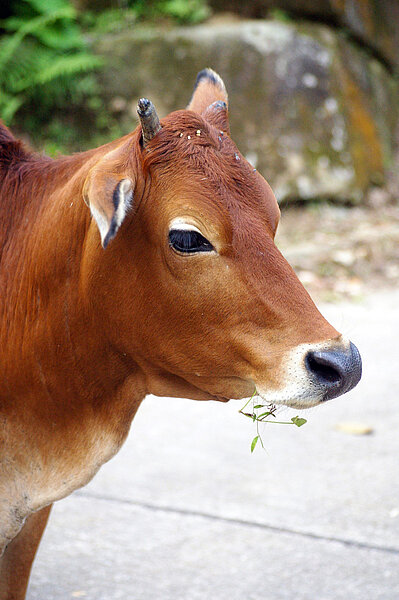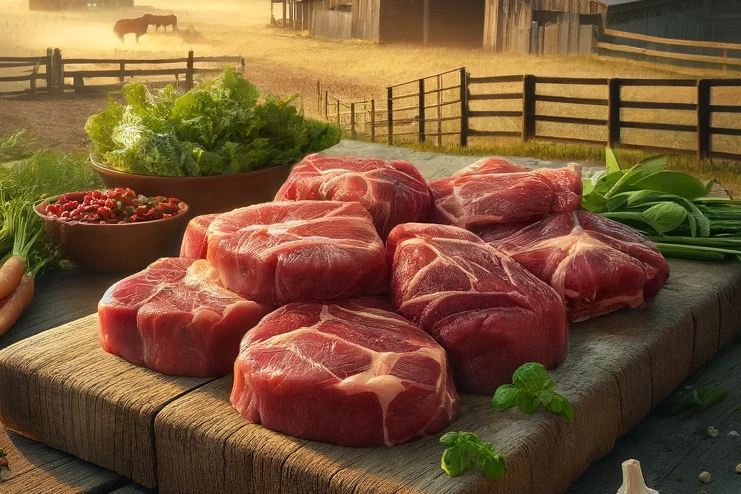Beef cheeks

Beef cheeks are a popular chew for dogs that offer many benefits. But what exactly are beef cheeks and what should you look out for when giving them to your dog? In this article, you'll find out everything you need to know about this ingredient.
What are beef cheeks?
Beef cheeks are part of the head meat of cattle. They consist of dark red, tender and rather lean meat that is surrounded by a thick skin. Beef cheeks are very muscular and have a high proportion of connective tissue as they are constantly in motion.
What are the benefits of beef cheeks for dogs?
Beef cheeks are a healthy chew for dogs that has many benefits:
- They are rich in protein, which is important for muscle building and regeneration.
- They contain little fat, which is good for the figure and the cardiovascular system.
- They have a high proportion of collagen, which strengthens the joints and connective tissue.
- They are digestible and do not burden the gastrointestinal tract.
- They clean the teeth and massage the gums, which promotes dental health.
- They offer long-lasting chewing fun and satisfy the dog's natural urge to chew.
- They are tasty and are readily accepted by most dogs.
What are the disadvantages of beef cheeks for dogs?
Beef cheeks are a high-quality chew for dogs, but they can also have some disadvantages:
- They can trigger allergies or intolerances if the dog is sensitive to beef.
- They can contain too much calcium if they are fed with the bone, which can lead to an imbalance in the mineral balance.
- They can be too large or too hard if not cut up or dried properly, which can lead to a risk of choking or dental injury.
How do you feed beef cheeks to dogs?
Beef cheeks can be fed to dogs as an occasional chew. There are a few points to bear in mind:
- The beef cheeks should be of good quality and come from species-appropriate and regional animal husbandry.
- The beef cheeks should be fresh or frozen and should not be stored for too long.
- The beef cheeks should be cut into suitable pieces for the size and age of the dog.
- Beef cheeks should only be fed raw or gently dried and should not be cooked or roasted.
- Beef cheeks should always be fed under supervision and should not be left unattended.
- Beef cheeks should be regarded as a supplement to the normal diet and not as the main feed.
Beef cheeks are a healthy and tasty chew for dogs that offers many benefits. However, they should only be fed in moderation and with caution to avoid possible disadvantages.
If you notice any signs of hypersensitivity or poisoning in your dog, you should see your vet immediately. We are not a substitute for a vet, but we try to be as accurate as possible. Every dog reacts differently and we recommend you get a second opinion or consult your vet if in doubt.
Stay healthy and take good care of your four-legged friend!😊
Similar to Beef cheeks
Buffalo cheeks are, as the name suggests, the meat obtained from the cheeks of a buffalo. This muscle meat is known for its toughness, as it has a high concentration of collagen. During the slow...
Venison cheeks are the muscle areas on the cheeks of a deer. Due to their high connective tissue content, they are considered particularly tasty when cooked slowly. In dog nutrition, however, they...
Veal cheeks are the meat that comes from the cheeks of the calf. This meat is particularly tender and flavorful because it comes from muscles that the animal moves frequently. In human cuisine, veal...
Pork cheeks are exactly what the name suggests - the meat that comes from the cheeks of a pig. This cut is known for its firm meat, which, when properly prepared, can be exceptionally tender and...



